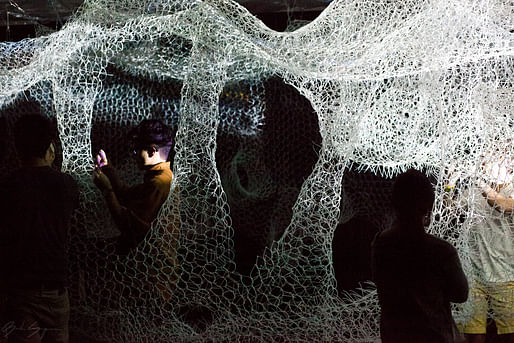
A quarter of a million zip ties altered a gallery into a bristled vortex of swirling, cavernous zip tie fabric magnified through reflective cellophane and augmented by subtle changing color. ZIP expresses the story of collaborative effort through research, acquisition, design, and construction of an environment designed as haptic reading room. Designed as an experience to exhibit thesis books, Professor Karen Lange’s fifth year studio (Studio400) at California Polytechnic State University (Cal Poly), San Luis Obispo, was assigned a collaborative installation project to showcase their previous personal research and transition into the design phase of their individual thesis projects.

Nineteen students worked tirelessly through the zipping, snipping, and stitching of the zip ties together composing an intricate three-dimensional fabric that could be swirled onto itself to create multiple experiences within a small storefront space. Entry portal, tubular book receptacles, undulating ceiling and walls, and vortex initiate a reading room, book storage, and entry foyer.

The installation was intended to showcase the thesis work done during the Fall 2012 quarter. The students each produced a book of design research, which related specifically to his or her developing project. The installation was constructed primarily of cable ties, looped and tied together, to create a fabric.


This fabric eventually encompassed an entire gallery “storefront” space. The design was developed over the course of three weeks culminating in a four- day installation period where students meticulously turned 250,000 cable ties into a fabric. The fabric was then tailored into an undulating surface that wrapped and curled into a cavernous room, displaying the thesis books. ZIP ultimately promoted visitor interaction with the fabric’s prickly surface, through books, light, music, color, and conversations, which allowed visitors to become involved in the students’ theses.

Studio400 brought forth the concept of a storefront installation exhibit as a spatial experiment while using limited materials as the construction medium.


The zip tie fabric unraveled to lure and signal visitors towards the entrance of the gallery where they are squeezed through the aciculate portal before entering the reading room. The installation’s central vortex expanse defined reading space with varying levels of seating. The installation intended to transport visitors from the mundane concrete reality of the building to a finely detailed space housing hand crafted books in an environment of subtle yet plastic enclosure.



Studio400
Professor Karen Lange
Studio400: Cadence Bayley, Juan Chavez, Seanna Drew, Kiley Feickert, Mathew Ho, Jack Hotho, Michelle Loeb, Tucker Marshall, Jeff Miner, Minami Mori, Emily Morillo, Erin Osberg, Hao Phung, Kristina Rakestraw, Brandon Sampson, Ismael Soto, Mike Sudolsky, Gabbi Sun, John Tuthill
Film Editing and Cinematography: Jack Hotho
Photos are credited/copyright of Brandon Sampson Photography



1 Comment
How exquisitely lovely and inventive. Too bad the material system and the general forms are a shameful copy of an installation done by LabStudio--Jenny Sabin, Peter Lloyd Jones, Andrew Lucia et.al., exhibited at Siggraph 2008, Ars Electronic in Linz 2009, and published as the winning visualization entry for Science magazine 2010. Good luck finding actually original ideas next time CalPoly.
Block this user
Are you sure you want to block this user and hide all related comments throughout the site?
Archinect
This is your first comment on Archinect. Your comment will be visible once approved.